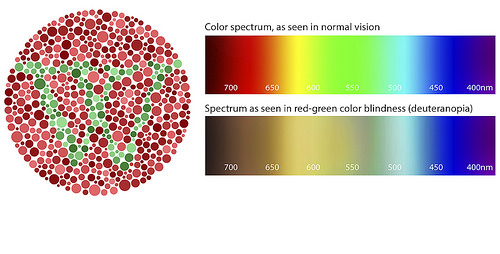Contrary to its name, color blindness does not mean that you cannot see any colors. You may see some colors just fine, but may be unable to distinguish between other colors.
What Causes Color Blindness?
Color blindness is usually inherited, although some conditions and diseases can also affect the way you see colors. When you are color blind, cones, special photoreceptor cells in your retina, do not work as well as they should. The retina is a layer of light-sensitive cells that lines the back of your eye. It sends visual signals to your brain, where they are interpreted as images. Although you may not be able to see some colors if you are color blind, the condition usually will not affect your overall vision.
What are the Types of Color Blindness?
Red-green color blindness is the most common form. People who have this type have varying degrees of difficulty telling the difference between red and green. Eight percent of men and .5 percent of woman of Northern European Ancestry have this deficiency, according to the National Eye Institute.
The condition is passed on to you from your mother, who carries a mutated gene on one of her X chromosomes. Women have two X chromosomes, while men only have one, which increases the risk that males who receive the mutated gene will develop the problem. If you are female and you receive a copy of the gene on one X chromosome, your healthy X chromosome can cancel out the damaged one. Males who have red-green color blindness can pass the gene on to their daughters.
Blue-yellow color blindness, the inability to distinguish between yellow and blue, is less common and equally likely in males and females because the defect is not located on the X chromosome. A very small percentage of people experience the complete loss of color vision, although this is very rare.
Does Everyone Experience Color Blindness the Same Way?
Different people may have very different levels of color blindness. One person may notice that red and orange colors have a green tinge, while others may see only black when they look at a red object. If you have no color vision, you may only see black, white and gray, and might only realize that something is a different color because it is darker or lighter than other objects.
What Can Be Done to Help People with Color Blindness?
There is no treatment or cure for color blindness currently, although researchers are conducting studies that may one day lead to a treatment or cure. If you have red-green blindness, your optometrist may recommend special lenses for your glasses that will make it easier to tell the difference between colors. As you can imagine, living with color blindness can create some challenges. You may not be able to see red warning lights, tell when the strawberries in your refrigerator have gone bad or realize that your clothes do not match. Luckily, several apps have been created to help people with color blindness recognize colors.
Are you concerned that you or someone you care about may suffer from color blindness? We offer color blindness testing that can help put your mind at ease. Call us today to schedule an appointment.
Increased Risk Factors for Color Blindness
Although most cases of color blindness are inherited, some people develop an acquired form of the disease. Risk factors for this type of color blindness include:
- Diseases. If you have leukemia, Alzheimer’s disease, diabetes, liver disease, glaucoma or macular degeneration, you may have an increased risk of developing some degree of color blindness.
- Trauma. Trauma to your brain or retina can cause color blindness. If you experienced shaken baby syndrome as an infant or received a blow to your head, you might develop an acquired case of color blindness. Retinal damage can occur for a variety of reasons, such as excessive exposure to ultraviolet light.
- Alcoholism. Alcoholism ups your chance of developing trouble distinguishing between colors.
- Cataracts. Cataracts can make colors look duller. Cataracts are usually related to aging and occur when the lens in your eye becomes cloudy. After cataract surgery, most people regain full color vision.
- Medications. Some medications can cause color blindness, including hydroxychloroquine, a prescription drug used to treat rheumatoid arthritis.
If you notice any change in your color vision, see your optometrist immediately, as these changes can be a sign of a serious vision problem.






